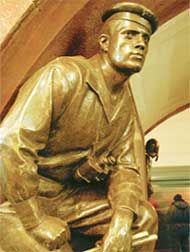British princess seduced Russian sailor
 Famous Soviet sculptor Matvey Manizer chose cadet of the Naval College Olimpy Rudakov as a prototype for the Red Navy man from the Marat battleship, one of the figures that he made for Moscow's underground station Ploshad Revolutsii (The Revolution Square). The sculptor could not even guess that in fifteen years the model would become a lover of the British princess.
Famous Soviet sculptor Matvey Manizer chose cadet of the Naval College Olimpy Rudakov as a prototype for the Red Navy man from the Marat battleship, one of the figures that he made for Moscow's underground station Ploshad Revolutsii (The Revolution Square). The sculptor could not even guess that in fifteen years the model would become a lover of the British princess.
In June 1953, Captain Olimpy Rudakov, the most handsome officer in the Baltic Fleet, brought the Sverdlov cruiser to Portsmouth to a naval parade dedicated to accession to the throne of Elizabeth II.
Captain Rudakov produced a sensation when he moored without assistance of a pilot and special maps three times quicker than British seamen traditionally did. All British newspaper published a picture of the smart captain.
At the naval parade next morning, the queen inspected ships in the Surprise yacht. Each guest ship was to fire one salvo to salute the queen’s yacht, but the Russian cruiser fired three salvos and its seamen shouted hurray. Then, captains of all vessels arrived at the Vanguard battleship where Elizabeth II decorated them with medals. American and French admirals were the first in the line, and Captain Rudakov just stood next to them. Contrary to the etiquette, the Queen first came up to Olimpy Rudakov and gave a medal to him, and only after that devoted attention to the American and French admirals.
Twenty officers of the Sverdlov cruiser and the captain were invited to the Coronation Ball. At the beginning of the party, Captain Rudakov presented Elizabeth II with an ermine mantle, the present of the Soviet Government.
After that, a man from the queen’s retinue told Olimpy that the Queen invited him for waltz. After one turn the Queen led the Soviet captain to her sister, and Princess Margaret started waltzing with Olimpy Rudakov. And again, the Queen broke the tradition and granted an audience to the Soviet captain, not official representatives of Russia. The Queen and the Soviet captain withdrew to her cabinet, which turned out to be so stunning that even Prime Minister Winston Churchill was at a loss and left the party.
Soon after Olimpy Rudakov got back to the cruiser, a van loaded with roses came to the pier. A card attached to the splendid present said the Princess gave it to the captain. The Soviet captain found it unusual to get presents from women, what is more he was allergic to flower scent. So, he ordered to put the roses in every cockpit. Just the order was carried out, the Princess moored to the cruiser in a boat.
The Princess found no flowers in Rudakov’s cabin and suspected her order was not carried out. But Olimpy Rudakov just explained the whole of the crew were charmed with the Princess and wanted to have some flowers from her too. The Princess was flattered and promised that more flowers would be delivered aboard next day. Next time she came to the Sverdlov cruiser, she openly told Olimpy Rudakov she liked him and wanted to spend some time with the Russian officer.
But Olimpy Rudakov felt panic at the idea that his rendezvous with the Princess may spoil his career. He explained the problem to the Princess, but the latter said she had a written permit of the Queen for the Princess to travel about British castles with the Russian captain within ten days. The captain called the Soviet Embassy and was allowed to spend two days with the Princess.
That year, Olimpy Rudakov turned 39; his career was an incredible success, as the captain became the youngest rear admiral of the Soviet fleet. After the British campaign, Olimpy Rudakov became head of a chair at the Navy Academy where he worked till his death in June 1974.
In 1954, Olimpy Rudakov was suggested as a candidate to the position if a naval attachй at the Soviet Embassy in Great Britain. But it is said Soviet Navy commanders turned the candidature down, as they felt envious of the fact that Rudakov won the Princess’ favor.
Marriage of an ordinary functionary from USSR’s Sovfracht Company Sergey Kauzov to multi-millionaire Christina Onassis was another sensational story pertaining to the Soviet fleet. The heiress of the richest men of the planet, Greek ship-owner Aristotle Onassis fell in love with the 40-year-old candidate of science when she visited Moscow.
Secretary General of the Soviet Union Leonid Brezhnev personally gave a permission for marriage to Sergey Kauzov. In August 1978, Christina and Sergey got officially married in Moscow, then had a honeymoon on the Baikal Lake and after that left for Paris. They stayed married within two years. Within the period, the Soviet Union successfully concluded commercial contracts to hundreds of millions of dollars, which were said to be concluded thanks to the marriage.
After the divorce, Sergey got two tankers and an apartment in London. Recently, Sergey Kauzov celebrated his 64th birthday; he purchased the controlling interest of the Latvian steamship line as a present for the birthday. Special services abroad still believe that Sergey Kauzov was a KGB agent.
Mikhail Kazakov
Subscribe to Pravda.Ru Telegram channel, Facebook, RSS!




